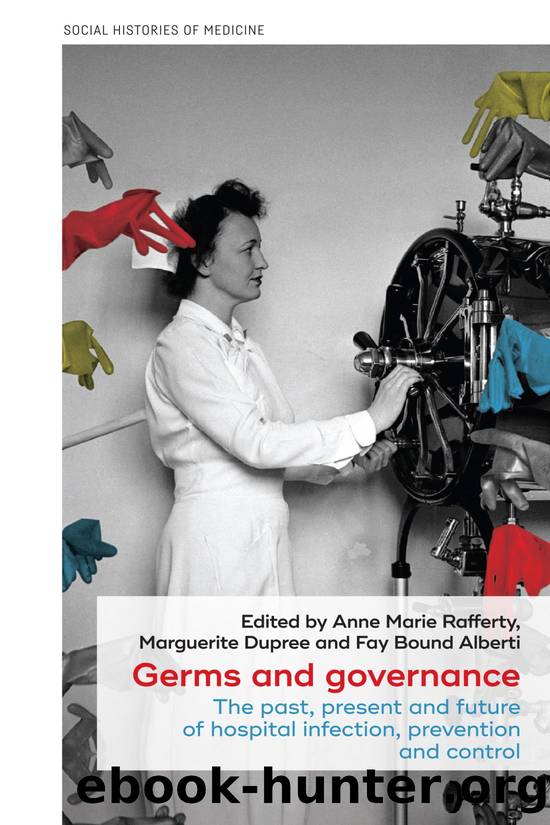Germs and governance by Anne Marie Rafferty Marguerite Dupree and Fay Bound Alberti

Author:Anne Marie Rafferty, Marguerite Dupree and Fay Bound Alberti
Language: eng
Format: epub
Publisher: Manchester University Press
Part III
Practice and infection control: Focus on gloves
6
Wax paste and vaccination: alternatives to surgical gloves for infection control, 1880â1945
Thomas Schlich
In this chapter, I discuss the history of various technologies for infection control in surgical operations. My account starts with the uptake of surgical gloves by practitioners in the late nineteenth century, which was a protracted process, and explains the relative disinterest of many surgeons in this particular technology by situating it in the context of other contemporary strategies of infection control. Exploring such alternative innovations shows that technological change in surgery and infection control does not happen in a vacuum. There are always multiple technological solutions to a problem. This chapter explores the alternatives to surgical gloves that were not taken up, arguing that this historical awareness provides a deeper understanding of the evolution of modern surgery and infection control.1
William Halsted and surgical gloves
Today, rubber gloves represent an important part of infection control in hospitals. In surgical operations, it is inconceivable for surgeons and nurses to work with their bare hands. Gloves were first used by operators during surgery in the 1880s. At the time, their introduction caused considerable controversy among surgeons, who only gradually adopted the innovation.2 If we look at the historical literature, we can see that many authors have been quite impatient about surgeonsâ hesitation to use surgical gloves. This impatience results from a teleological perspective on the history of medicine. From such a perspective, historians judge events and developments in the past according to whether they lead up to how things are now. In our case, it means that anything that was conducive to the use of surgical gloves is considered rational. Anything that went towards a different solution of the problem is judged to be irrational. For example, Justine Randers-Pehrson, in her historical account for the introduction of gloves, found it âcurious that it took lively minds so long to come around with the notion of an impermeable glove in surgeryâ. It was âeven more curiousâ, she wrote, that, âwhen the proposal was finally made in the eighteen-nineties, it required more than a decade of passionate argument before final universal acceptance could be achievedâ, explaining that âthe human mind does not always dart straight to the obviousâ.3 However, a closer investigation of the discussions at the time can show that surgeons had good reason to be sceptical about wearing gloves, including the loss of manual dexterity against the yet unproven benefits of gloves for infection control.4
There is one example in the history of surgical gloves that demonstrates how historians can benefit from a broader perspective when trying to understand why new techniques for infection control were accepted or rejected. It is the relatively well-known story of the first introduction of rubber gloves into the operating room (OR). This event happened in 1889 at the Johns Hopkins Hospital Department of Surgery, then headed by the famous William Halsted. As Halsted recalled it later, the nurse in charge of his OR âcomplained that the solution of mercuric
Download
This site does not store any files on its server. We only index and link to content provided by other sites. Please contact the content providers to delete copyright contents if any and email us, we'll remove relevant links or contents immediately.
The Art of Coaching by Elena Aguilar(50018)
Thinking, Fast and Slow by Kahneman Daniel(10588)
The Art of Thinking Clearly by Rolf Dobelli(8843)
The 5 Love Languages: The Secret to Love That Lasts by Gary Chapman(8499)
Mindhunter: Inside the FBI's Elite Serial Crime Unit by John E. Douglas & Mark Olshaker(7834)
Therapeutic Modalities for Musculoskeletal Injuries, 4E by Craig R. Denegar & Ethan Saliba & Susan Saliba(7349)
Periodization Training for Sports by Tudor Bompa(7329)
When Breath Becomes Air by Paul Kalanithi(7264)
Bodyweight Strength Training by Jay Cardiello(7185)
Becoming Supernatural by Dr. Joe Dispenza(7107)
Turbulence by E. J. Noyes(7040)
The Road Less Traveled by M. Scott Peck(6635)
Nudge - Improving Decisions about Health, Wealth, and Happiness by Thaler Sunstein(6633)
Enlightenment Now: The Case for Reason, Science, Humanism, and Progress by Steven Pinker(6406)
Win Bigly by Scott Adams(6312)
Mastermind: How to Think Like Sherlock Holmes by Maria Konnikova(6236)
Kaplan MCAT General Chemistry Review by Kaplan(6054)
The Way of Zen by Alan W. Watts(5800)
Why We Sleep: Unlocking the Power of Sleep and Dreams by Matthew Walker(5642)
